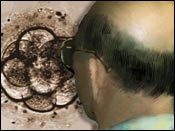Navigation
Hair Loss News Archives
September 2004
Cells May Grow New Hair, Skin
Sept 2004
(WebMD)
Special cells
nestled within the hair follicles in the skin may have the same
properties as stem cells and may offer a new way to treat hair loss and
burns, according to a new study.
Researchers found cells within the skin of mice that may have the
ability to eventually reverse baldness and improve wound healing by
multiplying and creating new hair and skin cells.
"We've identified cells within skin that bear all the characteristics of
true stem cells" -- the ability for self-renewal and the multipotency
required to become various types of tissue, such as skin and hair, says
researcher Elaine Fuchs, a cell biologist at Rockefeller University, in
a news release.
"The results demonstrate for the first time that
individual cells isolated from hair follicles can be cultured in the
laboratory and retain a capacity to make multiple cell types when
grafted."
The results appear in the Sept. 3 issue of the journal Cell.

Skin Cells Serve as Stem Cells
Embryonic stem cells, which are harvesting from an embryo in the early
days of development, have the ability to grow into hundreds of types of
cells within the body. But research using these types of cells is
controversial, and federal funding for research on embryonic stem cells
is limited in the U.S.
In contrast, adult stem cells found in various tissues in the body can
only reproduce themselves into various forms of the cells found within
the same type of tissue.
Researchers say by harnessing stem cells’
natural abilities to reproduce and replenish cells, they may be able to
develop new therapies to treat disease.
In this study, researchers demonstrated that a mammal's hair follicle,
in this case mice, has a reserve of stem cells known as the bulge that
can be mobilized to create many different types of cells needed to
produce new hair and skin.
When the bulge cells were grafted onto the backs of hairless mice, they
were able to reproduce and grow into new skin and hair follicles.
Researchers say their studies so far have been limited to mice, but the
presence of these cells in mice hold promise for finding similar cells
in human skin, which may lead to new treatments for baldness, burns, and
wound healing.
Furthermore, as more is known about what separates embryonic stem cells
from the more accessible adult stem cells, they may be able to learn how
to manipulate adult stem cells into new uses.
SOURCES: Blanpain, C. Cell, Sept. 3, 2004; vol 118: pp
635-648. News release, Cell Press.
